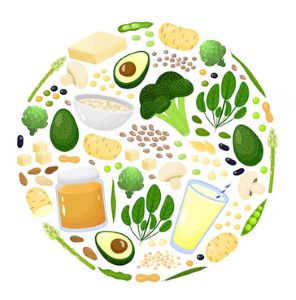Protein for Vegan Children
By Reed Mangels, PhD, RD
A couple of recent comprehensive summaries of research on vegetarian, including vegan, children have reported that protein intakes of vegetarian/vegan children are lower, on average, than those of nonvegetarian children. This is not concerning since, generally speaking, the same reviews found that vegetarian/vegan children have protein intakes that meet or exceed recommendations (1,2).
How much protein do children need?
The table below shows the Recommended Dietary Allowances (RDAs) for protein for children (3). Vegan children, as indicated in the table, may have slightly higher needs, since the digestibility and composition of plant proteins differ from animal proteins. Some dietitians have suggested that 2- to 6-year old vegan children get 20-30% more protein than the RDA and that older children (more than 6 years old) get 15-20% more protein (4). This adds up to a few grams more of protein per day – nothing difficult to achieve. The reference weight shown in the table is an average weight for a child of the specified age. It is multiplied by the protein recommendation (grams/lb) to get the protein recommendation in grams per day. You can use the protein recommendation in grams per pound multiplied by a specific child’s weight in pounds to calculate the recommendation for a child who weighs more or less than the reference weight.
Protein Recommendations for Children
| Age (years) | Reference weight (lbs) | Protein RDA (grams/lb) | Protein RDA (grams/day) | Protein Recommendation for Vegans (grams/lb) | Protein Recommendation for Vegans (grams/day) |
| 2-3 | 27 | 0.48 | 13 | 0.58-0.62 | 16-17 |
| 4-6 | 44 | 0.43 | 19 | 0.52-0.56 | 23-25 |
| 6-8 | 44 | 0.43 | 19 | 0.49-0.52 | 22-23 |
What do vegan children need to eat to meet protein recommendations?
These rules of thumb can be helpful in determining which foods and how much of those foods a child needs to eat to meet protein recommendations:
- ¼ cup of cooked dried beans, peas, or lentils has approximately 4 grams of protein
- ¼ cup of tofu has approximately 5-10 grams of protein
- 1 Tablespoon of peanut butter has 4 grams of protein
- 1 cup of soymilk has approximately 7 grams of protein
- ½ cup of cooked grains has approximately 3 grams of protein
- ½ cup of cooked vegetables has approximately 2 grams of protein
For an average 2-3-year old vegan, 2 servings (1/4 cup each) of cooked dried beans AND 2 servings (1/2 cup each) of cooked grains AND a half cup of soy milk would meet protein recommendations. Of course, additional healthy foods would be needed to supply adequate amounts of other nutrients.
To read more about protein see:
Protein for Vegans & Vegetarians
To read more about nutrition for vegan children see:
Vegan Nutrition in Pregnancy and Childhood
References
- Neufingerl N, Eilander A. Nutrient intake and status in children and adolescents consuming plant-based diets compared to meat-eaters: A systematic review. Nutrients. 2023;15(20):4341.
- Koller A, Rohrmann S, Wakolbinger M, et al. Health aspects of vegan diets among children and adolescents: a systematic review and meta-analyses. Crit Rev Food Sci Nutr. 2023.
- Institute of Medicine. Dietary Reference Intakes for Energy, Carbohydrate, Fiber, Fat, Fatty Acids, Cholesterol, Protein, and Amino Acids. Washington, DC: The National Academies Press; 2005.
- Mangels R, Messina V, Messina M. The Dietitian’s Guide to Vegetarian Diets, 4th edition. Burlington, MA: Jones & Bartlett Learning; 2023.
The contents of this website and our other publications, including Vegetarian Journal and Vegan Journal, are not intended to provide personal medical advice. Medical advice should be obtained from a qualified health professional. We often depend on product and ingredient information from company statements. It is impossible to be 100% sure about a statement, info can change, people have different views, and mistakes can be made. Please use your best judgment about whether a product is suitable for you. To be sure, do further research or confirmation on your own.

